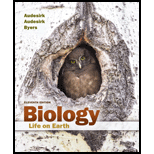
Concept explainers
The alleles responsible for antibiotic resistance in bacteria
a. arise in response to the presence of antibiotics.
b. are identical to the alleles responsible for pesticide resistance in insects.
c. are present in bacterial populations that have never been exposed to antibiotics.
d. are formed by interactions between antibiotic molecules and bacterial DNA.
Introduction:
Antibiotics works against the infection caused by bacteria. When the bacterial cells are able to resist the medication and the function provided by the antibiotic, they are said to be resistive in nature. Resistive microbes then become very rigid and make the task more difficult in order to treat them with antibiotics. Resistance can be employed for three reasons: resistance occurred naturally, resistance by a genetic mutation, and resistance acquired from the surroundings.
Answer to Problem 1MC
Correct answer:
The alleles responsible for antibiotic resistance in bacteria are present in bacterial populations that never been exposed to antibiotics.
Explanation of Solution
Justification for the correct statement:
Option (c) is given that alleles responsible for antibiotic resistance are present in bacterial populations that have never been exposed to antibiotics. Alleles are the variant form of genes encoding for the phenotypic traits of an organism. Bacterial infections are very difficult to irradicate, thus antibiotics are used. Overuse of these compounds resist the bacterial cell. Alleles, which were in continuous exposure to the antibiotics, die, whereas alleles which never been exposed to antibiotic mutate themselves and becomes resistance toward the antibiotic degrading effect. Thus, antibiotic-resistant alleles are those alleles that are present in the bacteria, which have never been exposed to the antibiotics. Therefore, option (c) is correct.
Explanation for the incorrect answers:
Option (a) is given that alleles responsible for antibiotic resistance arise in response to the presence of antibiotics. Generally, antibiotics degrade the process of cell membrane synthesis. Alleles responsible for the formation of cell membrane come in direct contact with the medicines and get killed. These were the alleles, which were selectively killed due to their formal encounter with the antibiotic. So, it is an incorrect option.
Option (b) is given that alleles responsible for antibiotic resistance are identical to the alleles responsible for pesticide resistance in insects. Plants and bacteria are very diverse not only structurally but functionally as well. Both of them do not share any kind of the evolutionary ancestor. The characters are responsibly encoded by different kinds of alleles. Due to the complexity in the body organization, no allele present in these two kinds of species shares a functional similarity. So, it is an incorrect option.
Option (d) is given that alleles responsible for antibiotic resistance are formed by interactions between antibiotic molecules and bacterial deoxyribonucleic acid (DNA). When antibiotic molecules interact with the bacterial DNA they tend to halt several processes, which stops their multiplication. Antibiotics are either bacteriocidal or bacteriostatic in nature. In both the cases, they degrade the functional attributes of the bacteria eventually resulting in it its death. So, it is an incorrect option.
Therefore, options (a), (b), and (d) are incorrect.
Therefore, it can be concluded that alleles responsible for antibiotic resistance in bacteria are present in bacterial populations that never been exposed to antibiotics. This is because any exposure to antibiotics results in the death of the bacteria, which is sensitive to it.
Want to see more full solutions like this?
Chapter 16 Solutions
Biology: Life on Earth (11th Edition)
- drawing chemical structure of ATP. please draw in and label whats asked. Thank you.arrow_forwardOutline the negative feedback loop that allows us to maintain a healthy water concentration in our blood. You may use diagram if you wisharrow_forwardGive examples of fat soluble and non-fat soluble hormonesarrow_forward
- Just click view full document and register so you can see the whole document. how do i access this. following from the previous question; https://www.bartleby.com/questions-and-answers/hi-hi-with-this-unit-assessment-psy4406-tp4-report-assessment-material-case-stydu-ms-alecia-moore.-o/5e09906a-5101-4297-a8f7-49449b0bb5a7. on Google this image comes up and i have signed/ payed for the service and unable to access the full document. are you able to copy and past to this response. please see the screenshot from google page. unfortunality its not allowing me attch the image can you please show me the mathmetic calculation/ workout for the reult sectionarrow_forwardIn tabular form, differentiate between reversible and irreversible cell injury.arrow_forwardhelparrow_forward
- Can you please help me answer these questions?arrow_forwardSkryf n kortkuns van die Egyptians pyramids vertel ñ story. Maximum 500 woordearrow_forward1.)What cross will result in half homozygous dominant offspring and half heterozygous offspring? 2.) What cross will result in all heterozygous offspring?arrow_forward
- 1.Steroids like testosterone and estrogen are nonpolar and large (~18 carbons). Steroids diffuse through membranes without transporters. Compare and contrast the remaining substances and circle the three substances that can diffuse through a membrane the fastest, without a transporter. Put a square around the other substance that can also diffuse through a membrane (1000x slower but also without a transporter). Molecule Steroid H+ CO₂ Glucose (C6H12O6) H₂O Na+ N₂ Size (Small/Big) Big Nonpolar/Polar/ Nonpolar lonizedarrow_forwardwhat are the answer from the bookarrow_forwardwhat is lung cancer why plants removes liquid water intead water vapoursarrow_forward
 Biology (MindTap Course List)BiologyISBN:9781337392938Author:Eldra Solomon, Charles Martin, Diana W. Martin, Linda R. BergPublisher:Cengage Learning
Biology (MindTap Course List)BiologyISBN:9781337392938Author:Eldra Solomon, Charles Martin, Diana W. Martin, Linda R. BergPublisher:Cengage Learning Concepts of BiologyBiologyISBN:9781938168116Author:Samantha Fowler, Rebecca Roush, James WisePublisher:OpenStax College
Concepts of BiologyBiologyISBN:9781938168116Author:Samantha Fowler, Rebecca Roush, James WisePublisher:OpenStax College Human Heredity: Principles and Issues (MindTap Co...BiologyISBN:9781305251052Author:Michael CummingsPublisher:Cengage Learning
Human Heredity: Principles and Issues (MindTap Co...BiologyISBN:9781305251052Author:Michael CummingsPublisher:Cengage Learning Biology: The Dynamic Science (MindTap Course List)BiologyISBN:9781305389892Author:Peter J. Russell, Paul E. Hertz, Beverly McMillanPublisher:Cengage Learning
Biology: The Dynamic Science (MindTap Course List)BiologyISBN:9781305389892Author:Peter J. Russell, Paul E. Hertz, Beverly McMillanPublisher:Cengage Learning





